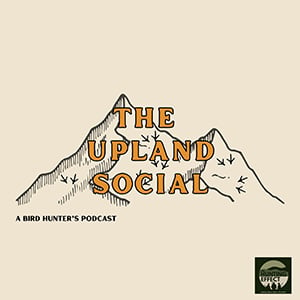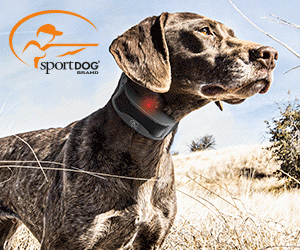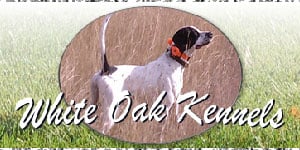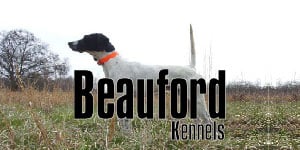4 Great Ways to Shoot Your Dog
Posted 05/21/2023
Karl, a German shorthaired pointer, zig zagged his way through the humid, early season corn maze. These South Dakota stalks stood tall, taller than even an NBA center, and if a bird flushed up it’d make for tricky shooting. To harvest a bird over a point, Karl’s owner knew he’d need to get out to the edge. When there was an opening he headed west, and stopped where the last row of stalks met the winter rye.
Karl knew the deal, and he had been snaking his way to the outside of the standing corn. His pattern was into the wind, his cast was sharp, and when he hit that field edge he got a whiff of scent and locked up on point. Karl’s owner was proud, and before taking off his safety he snapped a picture to commemorate the point. You can see it here.
Now if Karl’s owner was a friend I’d have said ‘you got his best side.’ But he was a recent acquaintance, so instead of mouthing off with a ‘fantastic shot of your dog’s butthole’ I kept quiet. Instead, I thought of a few ideas that might elevate the level of play. .
1.What story are you trying to tell?
Not a day goes by that I don’t hear someone reference the concept of ‘storytelling.’ It’s used so often that the concept has become a buzz word. Storytelling is a way of inviting a reader, a viewer or a listener into your world so you can show him what you see. There usually is a point, and that can vary from wanting to teach someone something, to share or discuss an idea, to motivate or to encourage or to simply entertain. Depth is always preferred to superficial, and connection to your audience should be at the forefront.

In this still life the story I’m telling is one of a traditional upland hunt for grouse and woodcock. The straight English stock on the Parker side-by is classic, as is the waxed cotton vest and the sheep bell on the collar. The birds are as uniquely traditional as upland hunting itself. To tell a modern story I could use a semi-automatic or an over/under and a pistol grip stock. A backpack made from ripstop nylon with lots of straps and a pocket containing a transmitter for a tracking collar. Shoot the scene on top of a YETI cooler. In the second still life I’m also telling a traditional upland story. Notice the texture in the image: a wood stock, metal barrels, cotton blue jeans, leather gloves, a waxed cotton vests, a patch of blaze orange and colorful plumage on the rooster pheasant. Each element in the story is traditional. Your story is yours to tell. Think about what you’re trying to say, put the pieces together, and invite your audience to come along for the ride. Raise the stakes a bit higher than just a tailgate shot with lots of dead birds. Anyone can do that.
2.Play to your strengths.
All members of the animal kingdom, and that includes Homo sapiens, have a dominant sense. When it comes to the sense of smell, a dog, a shark, a grizzly, and a rat, are a cut above the rest, so much so that a dog can detect the scent equivalent of one drop of water in a 70,000-gallon swimming pool. Humans also have a dominant sense, and ours is sight. To challenge my theory just head to your local paint store. The incredible variety of swatches illustrates that point.
Our strong sense of vision partially contributes to what’s known as a photographer’s eye. A photographer’s eye is how we see the world. Certainly, there is a literal component of what colors we notice, how sharp they are, and what kind of light we have. But more specifically, a photographer’s eye refers to the figurative and interpretive way he sees the world. What do you see when you walk into a room full of people, a kennel full of dogs, or gunroom with a rack full of shotguns? What people catch your eye? In the kennel, does your eye go to the pair of pointers in runs that are full of Labs? Are the markings on the pointers so similar that they look more than just littermates but that they look like identical twins? What shotguns catch your eye, the pumps, semis, over/unders or side-bys? What you see describes your eye. In the following pictures the story’s energy is one of ‘intensity.’

Try this: take your camera, go for a walk, and when you see something that interests you, shoot it. Don’t shoot something that you ‘think’ will make a good image or look cool on social. Shoot what captures your attention. If you’re walking with people then don’t ask them to pose, just snap away. Capture different settings, the changing light, and their different moods. Wait for a few days, and then review them with a critical eye, looking to understand any patterns that exist and what you were naturally drawn to. Pretty soon you’ll understand your eye you can spend more time developing it and feeding it. Your images will be natural, and they’ll dramatically improve.
3.How low can you go?
Perspective is an important part of capturing a good image. The easiest shot to make is to walk up when your dog is on point, pull out your camera and snap a pix. But those don’t always capture the moment either honestly or as you remember it. And that elevated view isn’t what the dog sees, and there are three ways to dramatically improve the view.
Drop to the dog’s level. I’ll never forget the first time I met my late friend, Chip Laughton. We worked together on a tremendous number of freelance pieces as well as client work. Chip was the first man I had ever seen who wore a pair of Filson, Double Tin bibs. His were shredded, with holes just about everywhere. The reason they were so tattered was that he spent more time shooting while on the ground. What I learned from him was that getting down to the dog’s level adds perspective. It shows the audience, the viewer, exactly what the dog sees. And in that the perspective teaches us that we can never value our dogs enough. They’re the ones running through thick cover, through grasses, and getting cut by barbed wire. They are the ones that are rock solid on point and never move. Next time you’re shooting a dog get down to their level. Lie on the ground but look around before you drop to the turf. You don’t wanna lay on a copperhead.
You can shoot a lot of different images when laying or sitting on the ground and when kneeling. While shooting some of Lloyd Murray of Long Gone Setters’s dogs Lloyd snapped a picture of me laying down on the job. I was photographing his dog Long Gone Mersadies.

Sadie (Long Gone Boston x Grouse Ridge Comet) was easy to shoot because she’s a broke dog. In this image I took advantage of the dip to get lower than her and show the thickness and darkness of the grouse cover, her intensity, and her style, right down to a high head and 12:00 tail set.

In a different cover I took a kneeling position to shoot another outstanding setter, this one being Dick Brenneman and Bob Watts’ Full Blast. Jeb (Cover Dog Setters’ Pennstar x Jim Chambers’ Walnut Hill’s Cracklin Patch) is bold, stylish and intense. He's broke, and that made him easy to shoot in a similar grouse cover’s thick terrain.
4.Find the correct amount of lead.
The working end of a dog is much more photogenic than his hindquarters. There are many ways to get in front of a dog so you can get a head first shot, a quartering shot, or a profile shot. The first is to pick up the camera and to put down the gun. Have your buddy shoot the birds while you shoot your camera. Or, if you’re in need of images, create set ups. Planted birds are easy and you’ll have a good understanding of where they are. Or, remember where you found birds before. There’s a reason you found them there, and since you’re likely to find them there again you can prepare to set up your shot. A pair of waders from the water is ideal for shooting Labs coming out of a blind door, or jumping off a boat or bank.

My wife’s setter Rebel (Lion Country’s Speedstar and I’m Lucky Too) was always fun to shoot from the front. He was an intense and stylish dog, and worked the camera as hard as he did the covers and fields. Think about the first image of Karl; imagine how good he’d look from the front…

Photography is fun, so play around with it as you see with the Sadie and Jeb brace. Change around from landscape to portrait, shift the focus of your subject matter, and have some fun. Study the work of other professional photographers and you’ll get a sense of what they’re looking for or at. To find a favorite photo just look through the pages of a upland or waterfowl magazine. Scroll online or on social media and when you find one who you like and identify with then dig deeper into his work to understand his view. It’ll help shape yours and elevate the quality of your own body of work.
Karl knew the deal, and he had been snaking his way to the outside of the standing corn. His pattern was into the wind, his cast was sharp, and when he hit that field edge he got a whiff of scent and locked up on point. Karl’s owner was proud, and before taking off his safety he snapped a picture to commemorate the point. You can see it here.
Now if Karl’s owner was a friend I’d have said ‘you got his best side.’ But he was a recent acquaintance, so instead of mouthing off with a ‘fantastic shot of your dog’s butthole’ I kept quiet. Instead, I thought of a few ideas that might elevate the level of play. .
1.What story are you trying to tell?
Not a day goes by that I don’t hear someone reference the concept of ‘storytelling.’ It’s used so often that the concept has become a buzz word. Storytelling is a way of inviting a reader, a viewer or a listener into your world so you can show him what you see. There usually is a point, and that can vary from wanting to teach someone something, to share or discuss an idea, to motivate or to encourage or to simply entertain. Depth is always preferred to superficial, and connection to your audience should be at the forefront.

In this still life the story I’m telling is one of a traditional upland hunt for grouse and woodcock. The straight English stock on the Parker side-by is classic, as is the waxed cotton vest and the sheep bell on the collar. The birds are as uniquely traditional as upland hunting itself. To tell a modern story I could use a semi-automatic or an over/under and a pistol grip stock. A backpack made from ripstop nylon with lots of straps and a pocket containing a transmitter for a tracking collar. Shoot the scene on top of a YETI cooler. In the second still life I’m also telling a traditional upland story. Notice the texture in the image: a wood stock, metal barrels, cotton blue jeans, leather gloves, a waxed cotton vests, a patch of blaze orange and colorful plumage on the rooster pheasant. Each element in the story is traditional. Your story is yours to tell. Think about what you’re trying to say, put the pieces together, and invite your audience to come along for the ride. Raise the stakes a bit higher than just a tailgate shot with lots of dead birds. Anyone can do that.
2.Play to your strengths.
All members of the animal kingdom, and that includes Homo sapiens, have a dominant sense. When it comes to the sense of smell, a dog, a shark, a grizzly, and a rat, are a cut above the rest, so much so that a dog can detect the scent equivalent of one drop of water in a 70,000-gallon swimming pool. Humans also have a dominant sense, and ours is sight. To challenge my theory just head to your local paint store. The incredible variety of swatches illustrates that point.
Our strong sense of vision partially contributes to what’s known as a photographer’s eye. A photographer’s eye is how we see the world. Certainly, there is a literal component of what colors we notice, how sharp they are, and what kind of light we have. But more specifically, a photographer’s eye refers to the figurative and interpretive way he sees the world. What do you see when you walk into a room full of people, a kennel full of dogs, or gunroom with a rack full of shotguns? What people catch your eye? In the kennel, does your eye go to the pair of pointers in runs that are full of Labs? Are the markings on the pointers so similar that they look more than just littermates but that they look like identical twins? What shotguns catch your eye, the pumps, semis, over/unders or side-bys? What you see describes your eye. In the following pictures the story’s energy is one of ‘intensity.’

Try this: take your camera, go for a walk, and when you see something that interests you, shoot it. Don’t shoot something that you ‘think’ will make a good image or look cool on social. Shoot what captures your attention. If you’re walking with people then don’t ask them to pose, just snap away. Capture different settings, the changing light, and their different moods. Wait for a few days, and then review them with a critical eye, looking to understand any patterns that exist and what you were naturally drawn to. Pretty soon you’ll understand your eye you can spend more time developing it and feeding it. Your images will be natural, and they’ll dramatically improve.
3.How low can you go?
Perspective is an important part of capturing a good image. The easiest shot to make is to walk up when your dog is on point, pull out your camera and snap a pix. But those don’t always capture the moment either honestly or as you remember it. And that elevated view isn’t what the dog sees, and there are three ways to dramatically improve the view.
Drop to the dog’s level. I’ll never forget the first time I met my late friend, Chip Laughton. We worked together on a tremendous number of freelance pieces as well as client work. Chip was the first man I had ever seen who wore a pair of Filson, Double Tin bibs. His were shredded, with holes just about everywhere. The reason they were so tattered was that he spent more time shooting while on the ground. What I learned from him was that getting down to the dog’s level adds perspective. It shows the audience, the viewer, exactly what the dog sees. And in that the perspective teaches us that we can never value our dogs enough. They’re the ones running through thick cover, through grasses, and getting cut by barbed wire. They are the ones that are rock solid on point and never move. Next time you’re shooting a dog get down to their level. Lie on the ground but look around before you drop to the turf. You don’t wanna lay on a copperhead.
You can shoot a lot of different images when laying or sitting on the ground and when kneeling. While shooting some of Lloyd Murray of Long Gone Setters’s dogs Lloyd snapped a picture of me laying down on the job. I was photographing his dog Long Gone Mersadies.

Sadie (Long Gone Boston x Grouse Ridge Comet) was easy to shoot because she’s a broke dog. In this image I took advantage of the dip to get lower than her and show the thickness and darkness of the grouse cover, her intensity, and her style, right down to a high head and 12:00 tail set.

In a different cover I took a kneeling position to shoot another outstanding setter, this one being Dick Brenneman and Bob Watts’ Full Blast. Jeb (Cover Dog Setters’ Pennstar x Jim Chambers’ Walnut Hill’s Cracklin Patch) is bold, stylish and intense. He's broke, and that made him easy to shoot in a similar grouse cover’s thick terrain.
4.Find the correct amount of lead.
The working end of a dog is much more photogenic than his hindquarters. There are many ways to get in front of a dog so you can get a head first shot, a quartering shot, or a profile shot. The first is to pick up the camera and to put down the gun. Have your buddy shoot the birds while you shoot your camera. Or, if you’re in need of images, create set ups. Planted birds are easy and you’ll have a good understanding of where they are. Or, remember where you found birds before. There’s a reason you found them there, and since you’re likely to find them there again you can prepare to set up your shot. A pair of waders from the water is ideal for shooting Labs coming out of a blind door, or jumping off a boat or bank.

My wife’s setter Rebel (Lion Country’s Speedstar and I’m Lucky Too) was always fun to shoot from the front. He was an intense and stylish dog, and worked the camera as hard as he did the covers and fields. Think about the first image of Karl; imagine how good he’d look from the front…

Photography is fun, so play around with it as you see with the Sadie and Jeb brace. Change around from landscape to portrait, shift the focus of your subject matter, and have some fun. Study the work of other professional photographers and you’ll get a sense of what they’re looking for or at. To find a favorite photo just look through the pages of a upland or waterfowl magazine. Scroll online or on social media and when you find one who you like and identify with then dig deeper into his work to understand his view. It’ll help shape yours and elevate the quality of your own body of work.
Related Aritlces
HOW TO TAKE BETTER PHOTOS OF YOUR GUN DOG
There is nothing we love more in our lives than our gun dogs; sorry to our spouses and significant others, but when was the last time they ran a blind retrieve, stopped on a whistle, or delivered a bird to hand? We have an ever-present desire to photograph our dogs and show them off to our friends and family, showcase our puppies and banter with our buddies. We have worked so hard to refine and polish our pup's skills and we want to make sure we're capturing and presenting them at their best.




















